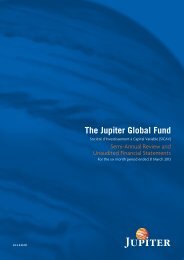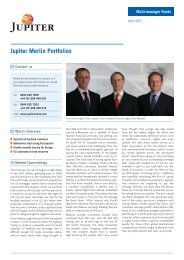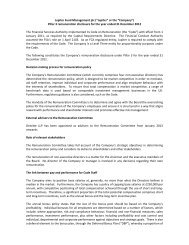The Jupiter Global Fund - Jupiter Asset Management
The Jupiter Global Fund - Jupiter Asset Management
The Jupiter Global Fund - Jupiter Asset Management
Create successful ePaper yourself
Turn your PDF publications into a flip-book with our unique Google optimized e-Paper software.
the jupiter global fund<br />
<strong>Jupiter</strong> Dynamic Bond<br />
■■<strong>Jupiter</strong> Dynamic Bond Review of Portfolio as at 30 September 2012<br />
Performance<br />
NAV 30.09.12<br />
Date of<br />
Inception*<br />
% Change<br />
Class L US Dollar Shares USD 10.40 USD 10.00 4.00%<br />
Class L Euro Shares EUR 10.40 EUR 10.00 4.00%<br />
Class L Sterling Shares GBP 10.41 GBP 10.00 4.10%<br />
Class L Swiss Franc Shares CHF 10.38 CHF 10.00 3.80%<br />
Class I US Dollar Shares USD 10.41 USD 10.00 4.10%<br />
Class I Euro Shares EUR 10.41 EUR 10.00 4.10%<br />
Class I Sterling Shares GBP 10.42 GBP 10.00 4.20%<br />
Class I Swiss Franc Shares CHF 10.39 CHF 10.00 3.90%<br />
* Inception date of 8 May 2012<br />
Market Review<br />
Shortly after the <strong>Fund</strong> was launched in May 2012, the Monetary Policy<br />
Committee voted to keep UK interest rates on hold at 0.5%, where<br />
they have now been for the past three years. <strong>The</strong> Bank of England<br />
commenced a further round of quantitative easing, despite already<br />
having repurchased approximately a third of the gilt market. Markets<br />
responded positively in June to the agreement reached by eurozone<br />
nations to offer support to the Spanish banking sector. Spain’s woes<br />
continued into July as yields on its government bonds rose to<br />
seemingly unsustainable levels. Commitment from European Central<br />
Bank (ECB) chief Mario Draghi to ‘do whatever it takes’ to preserve<br />
the Euro temporarily assuaged investor concerns and bond market<br />
performance improved in July. By August, it had become clear that a<br />
further monetary policy response was likely in both the United States<br />
and Europe, and trading volumes were thin as investors awaited the<br />
inevitable. Sure enough, at the start of September, Mario Draghi<br />
unveiled a European sovereign bond-buying programme called<br />
‘Outright Monetary Transactions’ and the US Federal Reserve<br />
announced a third and open-ended round of quantitative easing.<br />
Policy Review<br />
<strong>The</strong> <strong>Fund</strong> was launched on 8 May 2012. <strong>The</strong> <strong>Fund</strong> was only invested<br />
up to 70% for its first full month of trading and this contributed to<br />
outperformance in June. Corporate bond exposure was limited to<br />
defensive areas and financial holdings only comprised approximately<br />
8% of the <strong>Fund</strong>. Australian government bonds initially comprised a<br />
significant position but have been steadily reduced in the period under<br />
review as risk has been added. This is on the view that policy<br />
developments in Europe and the US have been positive for markets in<br />
general. Recently, we have been buying financials, adding to UK<br />
banks like Lloyds and RBS. <strong>The</strong>ir outstanding paper is diminishing as<br />
they continue to announce buybacks and we think there are ongoing<br />
buybacks in the pipeline that will typically execute at a decent premium<br />
to where they are trading in the secondary market. We are avoiding<br />
peripheral European banks but still getting decent returns from core<br />
European banks. Although a lot of returns have been booked from US<br />
financials, we still think they are pretty attractive versus the general<br />
investment grade market so banks like Goldman Sachs, Citigroup and<br />
Bank of America are core holdings for the <strong>Fund</strong>.<br />
Investment Outlook<br />
Our outlook for the remainder of the year is quite positive. <strong>The</strong><br />
introduction of a third round of Quantitative Easing (QE3) illustrates<br />
the Federal Reserve’s determination to support markets. In our view,<br />
there is currently a sustainable recovery taking place in the US. Higher<br />
risk assets will benefit from a deluge of liquidity that the market has yet<br />
to register fully, despite the rally since QE3 was announced.<br />
However, despite the fact that Europe appears to be coming to terms<br />
with the need to unite behind its debts and the commitment by the<br />
chairman of the ECB to do ‘whatever it takes’ to stave off disaster, it is<br />
hard to foresee meaningful economic growth in the near term.<br />
Macroeconomic data remains poor and if fundamentals fail to improve<br />
as we head into 2013, we will have to take a more cautious stance and<br />
de-risk the portfolio. China continues to be a key uncertainty, with a slew<br />
of mixed reports muddying the waters as to how the slowdown there is<br />
unfolding. In addition, as we get closer to the end of 2012, markets are<br />
becoming jittery about the US fiscal cliff. Commentators currently<br />
forecast a potential impact of 4% to US GDP but it is our understanding<br />
that there is a great deal of work going on behind the scenes to mitigate<br />
this to more like 1%. Ultimately, we believe that there is a political<br />
solution to the problem. Although the current environment has led to<br />
traditional ‘safe-haven’ assets such as UK government bonds and<br />
German bunds trading on very low yields, we believe that there are still<br />
plenty of attractive fixed interest investment opportunities available.<br />
However, we expect default rates, especially in Europe, to edge slowly<br />
higher, therefore it is crucial to be highly selective.<br />
Ariel Bezalel<br />
30 October 2012<br />
93








